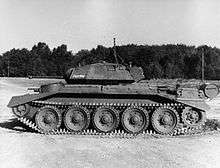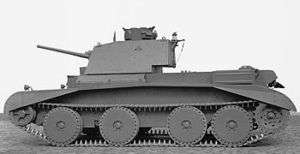Cruiser tank

| ||||||||||
The cruiser tank (also called cavalry tank or fast tank) was a British tank concept of the inter-war period. This concept was the driving force behind several tank designs which saw action during the Second World War. In British use, the cruiser formed part of a doctrine paired with the "infantry tank", a much slower but better armoured design intended to work in concert with the infantry in punching holes through enemy lines for the cruisers to exploit.
Background


Like the ships of the same name, cruiser tanks were intended to be fast and mobile, and operate independently. In this case, the independence was not from other ships in a fleet, but independence from the slow-moving infantry, their heavier infantry tanks, and artillery.
Once gaps had been punched in the enemy front by the infantry tanks, the cruisers were intended to penetrate to the rear, attacking lines of supply and communication in accordance with the theories of J.F.C. Fuller, P.C.S. Hobart, and B.H. Liddell-Hart. The cruiser tank was designed to be used in a way similar to cavalry in its heyday and thus speed was a critical factor, and to achieve this the early cruiser designs were lightly armoured and armed.
This emphasis on speed unbalanced the British designs; on limited engine power, the speed was only possible by sacrificing armour protection (by comparison infantry tanks operating at soldiers' pace could carry far more armour). At the time, the concept of "speed is armor" was considered the overriding concept in the British tank corps (unsurprising considering its birth in the Landships Committee of the Royal Navy, which also applied the concept to the ill-fated HMS Hood). It was not understood at the time that this principle of mobility over all else meshed poorly with the corresponding German policy of trading speed for superior armor and armament, ensuring that even a single round from a German medium tank could easily destroy a cruiser.
An even bigger problem for most cruiser tanks was the small calibre of their main gun. The first cruisers were armed with the QF two-pounder (40 mm) gun. This gun had adequate armour penetration against early war tanks, but was never issued high explosive ammunition. This made the cruisers less able to deal with towed anti-tank guns. However, as fighting enemy tanks was part of the projected role of the cruiser tanks, they were the first to be upgraded to the heavier 6 pounder (57 mm) gun when it became available, and a great deal of effort was put into developing cruiser tanks armed with the powerful 17 pounder QF (76 mm) gun when it became available. The Cromwell itself had too small a turret ring for a high powered gun - and carried a general purpose 75 mm gun - but benefitted from a high power engine giving it a maximum speed around 40 mph on roads.[1]
It was the following tank design in the British cruiser line, the Comet tank with a shortened 17 pdr, that entered service late in the war. As the UK had large numbers of US M4 Sherman tanks, the conversion of the Sherman to take a 17 pdr (as the Sherman Firefly) proved effective in providing more 17pdr gun tanks.
Ironically, despite the emphasis on high mobility, most cruisers were plagued by mechanical unreliability, most noticeably the Crusader tank in the hot and gritty desert of the North Africa Campaign. This problem was usually caused by insufficient development as most of the early cruiser tank designs were ordered "off the drawing board" in order to bring them into service as quickly as possible and was not fully solved until the debut of the Cromwell tank in 1944, with its powerful, reliable Rolls-Royce Meteor engine.
History
Interwar
In 1936 the British War Office designated two different kinds of tanks for future development: heavily armoured infantry tanks to be used in close co-operation with infantry during attacks, and fast mobile cruiser tanks (replacing the older "medium" class) designed to move quickly through enemy territory.
In 1934 Sir John Carden of Vickers-Armstrong produced a new medium tank, the A9,[2] using elements of the Medium Mk III design (which had been abandoned due to financial reasons) but lighter and using a commercial engine so it could be produced at lower cost.[3] It was subsequently accepted as an interim design for limited production as the Cruiser Tank Mark I. It was expected to be replaced by a Christie suspension design. In 1937–1938, 125 examples of the A9 were produced. The A9 was lightly armoured but capable of 25 mph and carried a QF 2pdr (40 mm) gun that was effective against current tanks.
At the same time as the A9, the A10, was also designed by Carden for use as an infantry tank. Built on basically the same design but with added armour plate to give 30 mm of protection. It was realised that it was insufficiently armoured for the role. Under "heavy cruiser" designation, it was put into production in July 1938 as another interim design. It had the same armament as the A9 and was the first to be equipped with the Besa machine gun. A total of 175 Mk IIs were produced by September 1940.[4]
Combat experience of the A9 during the Battle of France in 1940 was to reveal several shortcomings, including inadequate armour and a lack of space for the crew, but it nevertheless saw useful service in the Western desert in 1941. The A10 saw action in France, North Africa and Greece.
Orders for the Mk I and Mk II Cruisers were restricted, since the British Army had decided to produce a more advanced and faster cruiser tank which would incorporate the Christie suspension designed by American inventor J. Walter Christie and have better armour.

In 1936, General Martel, a pioneer in tank design who had published works on armoured warfare and pioneered the lightly armoured "tankette" to enhance infantry mobility, became Assistant Director of Mechanization at the War Office. Later that year Martel had witnessed Soviet tanks at the Red Army's autumn manoeuvres including the BT tank, which had they had developed from Christie's work. He urged the adoption of a tank that would use the suspension system and also follow Christie's practice of using a lightweight aircraft engine such as the Liberty Engine or a Napier Lion. The government authorized purchase and licencing of a Christie design via the Nuffield Organization.[5][6]
The tank - given the identity A13E1 - was very rudimentary and too small for British use, but the suspension was very effective and this became the basis of the Cruiser Mk III (A13). Following testing of two Nuffield-built prototypes (A13E2 and A13E3), the A13 was ordered into production and a total of 65 were manufactured by mid-1939.[7] The Mk III weighed 31,400 pounds (14.2 t), had a crew of 4, a 340 hp engine which gave a top speed of 30 mph (48 km/h) and was armed with a 40 mm 2 pounder gun and a machine gun. However, when it was introduced into service in 1937, the Army still lacked a formal tank division.[8] The trackless element of the Christie suspension was discarded as adding little value for the extra complexity.
The Cruiser Mk IV (A13 Mk II) was a more heavily armoured version of the Mk III. Production started in 1938.[9]
World War II


During early World War II, the Crusader was probably the best-known cruiser, it was first used in mid 1941 and thereafter used in large numbers in the Western Desert Campaign. The contemporary Covenanter was unreliable and was retained in the UK for training use.
The Cavalier, Centaur and Cromwell came out of the planned successor to the Covenanter and Crusader. Intended to be in production by 1942, the project was delayed and the Crusader was upgunned as an interim measure with the Mk.III 6 pounder gun. Cavalier was a development of Crusader. Centaur and Cromwell were an alternative design using the same engine as the Cavalier and the new Rolls-Royce Meteor engine respectively.
The Centaur and Cromwell saw action from the Invasion of Normandy onwards. The Comet was a development of the Cromwell using a modified 17 pounder gun and was fielded in the beginning of 1945. By this point in the war, the firepower and armour protection of the cruisers made them indistinguishable from medium tanks.
In the course of the war, technological improvements enabled heavier tanks to approximate the speed of the cruisers and the concept became obsolete. The last of their line was the Centurion. The Centurion was designed to satisfy the "Heavy Cruiser" criterion by combining the mobility of a cruiser tank and armour of an Infantry tank in one chassis. This idea - and the Centurion along with it - then evolved into the "Universal tank" concept, a design that could "do it all". Ultimately, the Centurion tank transcended its cruiser tank origins and become Britain's first modern main battle tank.
Cruiser tanks in other armies
The cruiser-tank concept was also employed by the Soviet Union in the 1930s, as exemplified by the BT tank series (Russian: bystrokhodniy tank, "fast tank").
See also
- History of the tank
- Tanks in World War I
- Comparison of World War I tanks
- Tanks of the interwar period
- Tanks in World War II
- Comparison of early World War II tanks
- Cold War Tanks
- Post-Cold War Tanks
- Armoured fighting vehicle
- Tank classification
References
Notes
- ↑ By comparison the M4 Sherman had a top speed on roads about 10 mph less; cross-country both tanks had similar maximum speeds
- ↑ Its General Staff number
- ↑ Chamberlain & Ellis (1969) p30
- ↑ Chamberlain & Ellis (1969) p31
- ↑ Milsom, John The Development of the Crusader Tank
- ↑ Chamberlain & Ellis (1969) p32
- ↑ Chamberlain & Ellis (1969) p32
- ↑ Steele, Brett D. (2005). Military Reengineering Between the World Wars. RAND. p. 14. ISBN 0-8330-3721-8.
- ↑ Chamberlain & Ellis (1969) p33
Bibliography
- Bingham, James, AFV Profile No. 8 Crusader-Cruiser Mark VI, Windsor: Profile Publishing
- Milson et al., Classic Armoured Fighting Vehicles Their History and How to Model Them Crusader 1976 Patrick Stephens
- Tucker, Spencer (2004). Tanks: An Illustrated History of Their Impact. ABC-CLIO. pp. 49–51. ISBN 1-57607-995-3.
| ||||||||||||||||||||||||||||||||||||||
| ||||||||||||||||||||||||||||||||||||||||||
| ||||||||||||||||||||||||||||||||||
| ||||||||||||||||||||||||||||||||||||||||||||||||||